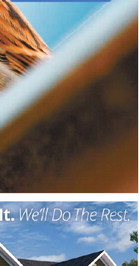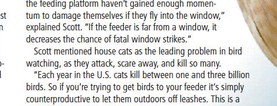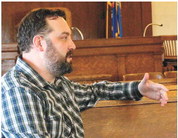Birdwatcher’s sights soar towards Spring Migration
With the Spring thaw underway, local bird watchers are looking forward to the ensuing influx of birds during the 2020 Spring Migration. In anticipation of the migration, president of the Chequamegon Bird Club Joe Scott shared his knowledge on the local population, along with some pointers on birdwatching, or “birding” as practitioners refer to it, for those looking to start a new hobby.
“Purple finch numbers increase; some stayed throughout the winter. Fox sparrows are passing through any day now. White and red-breasted nuthatches are a possibility. Blue jays and chickadees spend all winter here but they are joined at the feeder by the newly-arrived evening grosbeak.”
Scott said birds that favor the rural country are often the prettiest to look at, but are also the most difficult to find. Warblers, he specified, are one of the most intriguing birds to scour the countryside for. “With visually descriptive names like yellowrumped, blackthroated green, yellow-throat, and goldencrowned, warblers are as much fun to listen to as they are to find; usually trying to find them in a pair of binoculars encourages as much frustration and cursing as joy when actually spotting them.” He noted that many predatory birds have been arriving for the past couple of weeks in conjunction with the thaw, already staking out territories in forests and fields. “If you live in farm country or have a more open setting with a few trees around, you usually have the same options as the city folk with a few additions. information for beginning birders.”
While the Chequamegon Bird Club normally meets monthly, that’s currently on hold, though those who are interested are still encouraged to reach out.
Scott added “We welcome non-members at our meetings, or check us out on Facebook. Anyone interested in attending a club meeting, setting up guided tours, or with general bird questions can contact me at president@chequamegonbirdclub.org or call 715-965-3498.”
oa o d g crow t
e f curs a spottin s c fo al tiv lik rum thro yell bir ar co co th st rie fa h s t u s t Many hawks and raptors have already returned. Those include the northern harrier and American kestrel.”
The type of foliage surrounding a property has an affect on what birds will visit, as different species seek out certain kinds of trees to nest in.
“Maybe you or one of your neighbors on the block have spruce or balsam trees,” Scott said. “Then you have the opportunity to hear one of my favorite spring birds: the ruby-crowned kinglet. They are one of the smallest songbirds, so finding them before hearing them is difficult, but they have a pretty longwinded song given their size.”
He went on to say that jelly, sugar water, or fruit are the best foods for attracting small, brightly colored birds such as Baltimore orioles and ruby-throated hummingbirds.
“Put out a dish of grape jelly or orange halves... A one-to-four sugar to water ratio is sufficient to keep the hummers happy, but do not dye the water,” he said. “There’s really no reason to use dye since hummingbird feeders typically have red components to gain the birds’ attention.”
Scott suggested black oil sunflower seeds as an avian catchall, and said the addition of suet can increase the range of bird species visiting a feeder: “Suet is high in protein and will bring in woodpeckers, nuthatches, chickadees, and the insect-eating birds that come back a little bit too early.”
The amount of cover around a bird feeder contributes heavily to how often birds frequent it, as they need to feel safe while eating. Brush and tall grass provide adequate hiding spots for most birds to be comfortable.
“Birds don’t want to feel overly exposed while on the feeder, so placement by vegetation that will provide cover is a good first step,” Scott said, adding that hanging a bird feeder from a tree branch isn’t the best idea, because it provides such easy access for squirrels.
As a general rule, bird feeders shouldn’t be placed between three feet and 30 feet near a building to help reduce the amount of window-related bird fatalities, so feeders should be placed immediately next to the building or far away from it.
“If a feeder is right next to a window, birds flying off the feeding platform haven’t gained enough momentum to damage themselves if they fly into the window,” explained Scott. “If the feeder is far from a window, it decreases the chance of fatal window strikes.”
Scott mentioned house cats as the leading problem in bird watching, as they attack, scare away, and kill so many.
“Each year in the U.S. cats kill between one and three billion birds. So if you’re trying to get birds to your feeder it’s simply counterproductive to let them outdoors off leashes. This is a topic that makes birders’ blood boil.”
For those interested in bird watching as a new hobby to pick up, Scott suggested libraries, when they reopen, as an excellent source of information and equipment.
“Within the last several years the Chequamegon Bird Club donated ‘Birding Backpacks’ to all the area libraries. These backpacks contain binoculars, bird identification books, and lots of tidbits of The Great Wisconsin Birdathon, a fundraising event that supports numerous bird conservation projects and has raised over half a million dollars since 2012, is one of few community events to not be canceled amidst the COVID-19 pandemic. The rules, however, were modified to better reflect social distance policies. The fundraiser involves people of all ages, from kindergarteners to the keenest of bird watchers, who collect pledges and donations based on the amount of birds they can spot in a single day. The Birdathon normally takes place between April 15 and June 15, with teams selecting one day as their bird-searching day, on which they trek out in teams in search of birds. This year, the Birdathon will extend from April 15 to Oct. 15 to allow participates ample time to pick a day on which to safely observe as many birds as they can. New guidelines include recommendations of birding solo rather than in teams, and staying away from frequented parks.
Birdathon will allow any 501c3 organization contributors to keep half of the money they raise, to be used by their discretion. The aim is to help participating businesses that may be struggling financially amidst the COVID-19 crisis. Registration for the Great Wisconsin Birdathon is still open, with solo teams are encouraged to apply.
yellowped, blackated , un o es n y ” at y ve tion w,
territoorests
ou ountry round, y y dditions. ated gree owgoldenned, s fu y ncourage rustration sing jo ng
tha
p g
fififi
a pply.
by Sam Weber, Reporter

















